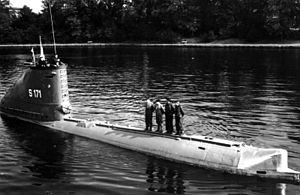German submarine U-2356
 Postwar photo of Hecht (S 171), (former Type XXIII submarine U-2367). An identical sister ship of U-2356.
| |
| History | |
|---|---|
| Name | U-2356 |
| Ordered | 20 September 1944 |
| Builder | Deutsche Werft AG, Hamburg |
| Yard number | 510 |
| Laid down | 21 October 1944 |
| Launched | 19 December 1944 |
| Commissioned | 12 January 1945 |
| Fate |
|
| General characteristics | |
| Class and type | Type XXIII submarine |
| Displacement | |
| Length | |
| Beam |
|
| Draught | 3.66 m (12 ft) |
| Installed power |
|
| Propulsion |
|
| Speed |
|
| Range |
|
| Test depth | 180 m (590 ft) |
| Complement | 14–18 |
| Armament |
|
| Service record | |
| Part of: |
|
| Identification codes: | M 50 346 |
| Commanders: | |
| Operations: | None |
| Victories: | None |
German submarine U-2356 was a Type XXIII U-boat of Nazi Germany's Kriegsmarine during World War II. She was ordered on 20 September 1944, and was laid down on 21 October 1944 at Deutsche Werft AG, Hamburg, as yard number 510. She was launched on 19 December 1944 and commissioned under the command of Oberleutnant zur See Friedrich Hartel on 12 January 1945.[2]
Design
Like all Type XXIII U-boats, U-2356 had a displacement of 234 tonnes (230 long tons) when at the surface and 258 tonnes (254 long tons) while submerged. She had a total length of 34.68 m (113 ft 9 in) (o/a), a beam width of 3.02 m (9 ft 11 in) (o/a), and a draught depth of 3.66 m (12 ft). The submarine was powered by one MWM six-cylinder RS134S diesel engine providing 575–630 metric horsepower (423–463 kilowatts; 567–621 shaft horsepower), one AEG GU4463-8 double-acting electric motor electric motor providing 580 PS (430 kW; 570 shp), and one BBC silent running CCR188 electric motor providing 35 PS (26 kW; 35 shp).[3]
The submarine had a maximum surface speed of 9.7 knots (18.0 km/h; 11.2 mph) and a submerged speed of 12.5 knots (23.2 km/h; 14.4 mph). When submerged, the boat could operate at 4 knots (7.4 km/h; 4.6 mph) for 194 nautical miles (359 km; 223 mi); when surfaced, she could travel 2,600 nautical miles (4,800 km; 3,000 mi) at 8 knots (15 km/h; 9.2 mph). U-2356 was fitted with two 53.3 cm (21 in) torpedo tubes in the bow. She could carry two preloaded torpedoes. The complement was 14–18 men.[3] This class of U-boat did not carry a deck gun.[2]
Service history
On 5 May 1945, U-2356 surrendered at Cuxhaven, Germany. She was later transferred to Lisahally, Northern Ireland on 21 June 1945. Of the 156 U-boats that eventually surrendered to the Allied forces at the end of the war, U-2356 was one of 116 selected to take part in Operation Deadlight. U-2356 was towed out and sank on 6 January 1946, by gunfire from the British destroyer HMS Onslaught.[2]
The wreck now lies at 55°50′N 08°20′W / 55.833°N 8.333°W.[2]
See also
References
- ^ Helgason, Guðmundur. "Friedrich Hartel". Uboat.net. Retrieved 29 April 2016.
- ^ a b c d Helgason, Guðmundur. "U-2356". Uboat.net. Retrieved 29 April 2016.
- ^ a b Gröner 1991, p. 89.
Bibliography
- Busch, Rainer; Röll, Hans-Joachim (1999). German U-boat commanders of World War II : a biographical dictionary. Translated by Brooks, Geoffrey. London, Annapolis, Md: Greenhill Books, Naval Institute Press. ISBN 1-55750-186-6.
- Gröner, Erich; Jung, Dieter; Maass, Martin (1991). U-boats and Mine Warfare Vessels. German Warships 1815–1945. Vol. 2. Translated by Thomas, Keith; Magowan, Rachel. London: Conway Maritime Press. ISBN 0-85177-593-4.
- Williamson, Gordon (2005). Wolf Pack: The Story of the U-boat in World War II. Osprey. ISBN 1841768723.
External links
- Helgason, Guðmundur. "U-2356". Uboat.net. Retrieved 29 April 2016.
- Articles with short description
- Short description matches Wikidata
- Use dmy dates from April 2016
- Coordinates on Wikidata
- U-boats commissioned in 1945
- World War II submarines of Germany
- 1944 ships
- Type XXIII submarines
- Ships built in Hamburg
- Operation Deadlight
- World War II shipwrecks in the Atlantic Ocean
- Maritime incidents in 1946